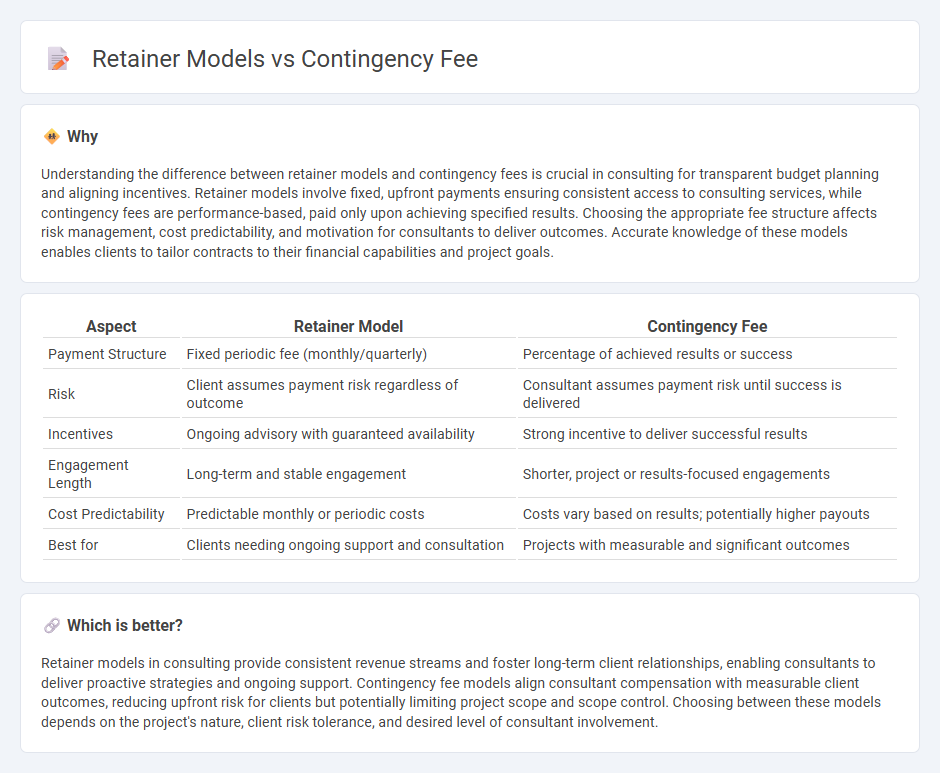
Consulting retainer models provide clients with consistent access to expert services through a fixed monthly fee, ensuring ongoing support and strategic guidance. Contingency fee models align consultant compensation with project success, where fees are earned based on achieving specific agreed-upon outcomes or results. Explore the distinct advantages of retainer and contingency fee structures to determine the optimal consulting engagement for your business goals.
Why it is important
Understanding the difference between retainer models and contingency fees is crucial in consulting for transparent budget planning and aligning incentives. Retainer models involve fixed, upfront payments ensuring consistent access to consulting services, while contingency fees are performance-based, paid only upon achieving specified results. Choosing the appropriate fee structure affects risk management, cost predictability, and motivation for consultants to deliver outcomes. Accurate knowledge of these models enables clients to tailor contracts to their financial capabilities and project goals.
Comparison Table
| Aspect | Retainer Model | Contingency Fee |
|---|---|---|
| Payment Structure | Fixed periodic fee (monthly/quarterly) | Percentage of achieved results or success |
| Risk | Client assumes payment risk regardless of outcome | Consultant assumes payment risk until success is delivered |
| Incentives | Ongoing advisory with guaranteed availability | Strong incentive to deliver successful results |
| Engagement Length | Long-term and stable engagement | Shorter, project or results-focused engagements |
| Cost Predictability | Predictable monthly or periodic costs | Costs vary based on results; potentially higher payouts |
| Best for | Clients needing ongoing support and consultation | Projects with measurable and significant outcomes |
Which is better?
Retainer models in consulting provide consistent revenue streams and foster long-term client relationships, enabling consultants to deliver proactive strategies and ongoing support. Contingency fee models align consultant compensation with measurable client outcomes, reducing upfront risk for clients but potentially limiting project scope and scope control. Choosing between these models depends on the project's nature, client risk tolerance, and desired level of consultant involvement.
Connection
Retainer models and contingency fee structures are connected through their common goal of aligning client and consultant incentives while managing risk. Retainers provide ongoing access to consulting expertise with predictable costs, whereas contingency fees tie payment to specific outcomes, motivating consultants to achieve measurable results. Combining these models can balance steady consulting support with performance-driven compensation, optimizing resource allocation and project success.
Key Terms
Payment Structure
Contingency fee models require payment only if the attorney secures a favorable outcome, typically a percentage of the settlement or judgment, reducing upfront costs for clients. Retainer models involve an upfront fee paid to secure legal services, often billed hourly against this deposit, providing predictable income for attorneys regardless of case outcome. Explore these payment structures further to determine which aligns best with your legal needs.
Risk Allocation
Contingency fee models allocate risk to the attorney, as payment depends on winning the case, aligning their interests with the client's success, while retainer models place financial risk on the client through upfront fees regardless of outcome. This risk distribution affects client accessibility to legal services and incentivizes attorneys differently in each arrangement. Explore how these fee structures impact legal strategy and client decision-making for deeper insight.
Client Commitment
Contingency fee models align lawyer compensation with case outcomes, requiring no upfront payment and fostering strong client commitment, especially in personal injury and civil litigation. Retainer models demand upfront fees, ensuring dedicated legal services while securing client investment in ongoing representation tailored to complex or corporate cases. Explore the advantages and client implications of each fee structure to make informed legal service decisions.
Source and External Links
contingent fee | Wex | US Law | LII / Legal Information Institute - A contingency fee is a form of lawyer compensation where the lawyer receives a percentage of the client's monetary award rather than an hourly rate, commonly around 33% in personal injury cases, with agreements required to be in writing and certain case types, like divorce or criminal defense, prohibited from contingency fees.
Contingent fee - Wikipedia - A contingent fee is a payment structure for legal services where the lawyer's fee is paid only upon a successful lawsuit or favorable settlement, usually as a percentage of the recovery, enabling clients with limited resources to access legal representation.
What Is a Contingency Fee? - FindLaw - Contingency fees are commonly used in personal injury cases where the lawyer is paid a percentage (typically 33%-40%) of the settlement or award only if the case is won, allowing clients to avoid upfront legal fees and making legal help more accessible.
 dowidth.com
dowidth.com